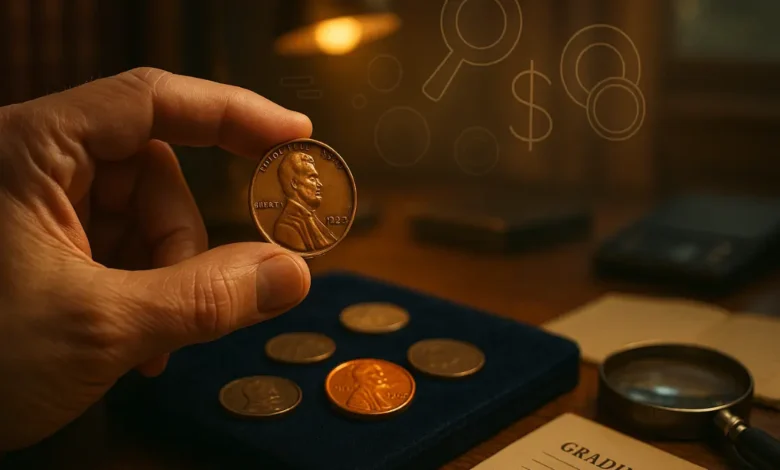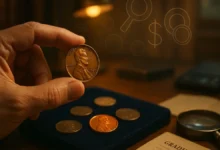Rare Pennies: Small Coins with Big Stories

Explore the fascinating world of rare pennies — from hidden mint errors to legendary rarities. Learn how to spot, value, and collect these small but mighty coins in this expert‐style but easy‐to-understand guide.
Most people glance at a penny and think nothing of it. After all, it’s just a single cent — a coin so small it often gets lost under couch cushions or left behind at the checkout counter. But what if that tiny coin in your pocket was worth hundreds or even thousands of dollars? That’s the magic of rare pennies.
Collectors and enthusiasts know that among the billions of common cents minted over the years, a handful stand out as extraordinary. These coins are rare not because of their face value, but because of history, craftsmanship, or minting mistakes that make them one-of-a-kind. Owning a rare penny isn’t just about money — it’s about holding a piece of history that tells a unique story.
In this article, we’ll explore what makes certain pennies rare, the most famous examples, how to identify potential treasures, how to care for and value them, and the myths to avoid if you’re diving into coin collecting. Whether you’re an experienced numismatist or someone who’s simply curious, this guide will help you see those copper and zinc coins in a whole new light.
What Makes a Penny Rare
A penny doesn’t have to be old to be rare. The value and rarity of a coin depend on a mix of several factors — including mintage numbers, condition, and even minting errors. Let’s break down what truly makes a rare penny stand apart.
Low Mintage and Scarcity
Some pennies were simply not made in large numbers. When a mint produces a small batch of coins, and many of those are later melted down or lost, the remaining examples become valuable. The lower the surviving population, the higher the rarity.
For example, early 20th-century coins often had small mint runs, especially at certain U.S. Mint branches. Collectors refer to these “key date” pennies as the hardest to find — and they usually anchor any serious coin collection. Even if the coin design itself isn’t special, its scarcity alone makes it sought-after.
Mint Errors and Unusual Features
Another major reason a penny becomes rare is because of minting errors. Coins are produced using high-pressure presses that stamp metal planchets with engraved designs. But sometimes, things go wrong — and when they do, collectors take notice.
Common error types include double dies, off-center strikes, and wrong-metal planchets. When the lettering, numbers, or portraits are doubled, misaligned, or missing entirely, that coin becomes unique. Such anomalies aren’t supposed to happen, and that’s exactly what makes these rare pennies fascinating and valuable.
Condition and Preservation
Even a rare design loses value if it’s badly worn. Collectors pay top dollar for coins in pristine condition, often described as “mint state” or “uncirculated.” Coins that still show their original shine and fine details are exponentially more valuable than those with scratches or discoloration.
That’s why coin grading exists — to measure a coin’s quality. The difference between a “Fine” and a “Mint State” rare penny can mean hundreds or even thousands of dollars in value.
Historical Significance
Finally, some pennies gain legendary status because of their connection to historical moments. Coins struck during war years, political changes, or design controversies often become cultural icons. They represent more than currency — they symbolize moments in history captured in metal.
Famous Rare Pennies Every Collector Should Know
Some pennies have become legends in the world of numismatics. Their stories combine historical intrigue, minting mishaps, and sheer luck. Here are a few examples that define what rare pennies truly mean.
The 1909-S VDB Lincoln Cent
When the Lincoln penny was introduced in 1909, it was the first U.S. coin to feature a real person’s likeness — President Abraham Lincoln. The designer, Victor David Brenner, included his initials “VDB” on the reverse. However, public backlash over the prominent initials led to the Mint quickly removing them.
Only a small number of those original 1909 pennies with the “VDB” initials were made in San Francisco, marked by an “S” below the date. That combination — low mintage, historical change, and distinctive markings — makes the 1909-S VDB Lincoln Cent one of the most famous and valuable rare pennies in existence.
The 1943 Copper Penny
During World War II, copper was desperately needed for ammunition and military equipment. To save metal, the U.S. Mint struck pennies in 1943 using zinc-coated steel instead of copper. However, a few leftover bronze planchets from 1942 accidentally got used, resulting in a small number of 1943 pennies made of copper.
These rare pennies are among the most legendary error coins in the world. They look like ordinary pre-war pennies but are magnetic because of their steel counterparts — making them easy to test. Authentic 1943 copper pennies have fetched hundreds of thousands of dollars at auctions, proving that sometimes a mistake can turn into a masterpiece.
The 1955 Doubled Die Cent
In 1955, a major die misalignment caused the coin’s lettering and date to appear doubled. The mistake wasn’t caught immediately, and thousands of coins entered circulation. The result is one of the most striking and desirable error coins ever made.
Collectors instantly recognize this rare penny by its doubled “Liberty” and “In God We Trust.” Even heavily circulated examples command high prices, while well-preserved ones are worth several thousand dollars or more.
The 1930 Australian Penny
Outside the United States, one of the world’s most famous rare pennies is the Australian 1930 penny. Minted in extremely limited numbers during the Great Depression, only a few thousand are known to exist. Its scarcity, combined with its distinct design, makes it one of Australia’s most prized collectible coins.
This coin’s appeal goes beyond its country of origin — it symbolizes how global economic turmoil affected even small pieces of metal money, transforming them into historical artifacts.
The British Suffragette Penny
In early 20th-century Britain, activists fighting for women’s voting rights sometimes defaced pennies by engraving the slogan “Votes for Women” across the coin’s surface. These altered coins, known as Suffragette pennies, became enduring symbols of protest and equality.
Although technically not mint errors, their rarity and powerful historical meaning make them extremely valuable. Very few survive, and those that do are cherished both for their political message and their connection to social change.
How to Identify a Rare Penny in Your Collection
You might be wondering — could one of those forgotten pennies in a jar at home actually be rare? It’s possible. Finding a valuable coin takes knowledge, patience, and a bit of luck. Here’s how to tell if your penny might be special.
Check the Date and Mint Mark
Every penny carries a date and often a mint mark — a small letter that tells where it was produced. Some combinations are rarer than others. For example, coins minted in San Francisco or Denver during certain years had smaller production runs. Always pay attention to these details; they’re the first clue in spotting rarity.
Inspect for Errors or Oddities
Next, look closely for mistakes. Doubling in the numbers or letters, missing details, or misaligned designs are all potential signs of minting errors. Use a magnifying glass or coin loupe under good lighting. Sometimes, a rare penny hides in plain sight because people assume the error is just damage.
Test the Metal
If you think you’ve found a rare penny from a year when different materials were used — such as the 1943 copper penny — try a few simple tests. Use a magnet; if it sticks, it’s steel. Weigh the coin as well, since each metal composition has a specific standard weight. These small details can confirm or rule out certain rare varieties.
Compare and Research
Use trusted coin guides, collector books, and online photos to compare your coin. Look for differences in strike details, spacing, or shape. Even tiny variations can separate a common penny from a rare one.
Get a Professional Opinion
If you’re confident your coin might be valuable, don’t clean it or attempt restoration. Instead, send it to a professional grading service. Certified grading provides authentication, assigns a quality score, and seals the coin to protect it. This not only preserves its condition but also increases its credibility and resale value.
How Rare Pennies Are Valued
Value in the coin world isn’t random — it’s based on measurable factors that determine a coin’s desirability and market worth. Understanding these helps you know whether you’re holding a treasure or a trinket.
Condition and Grade
The first and biggest factor is condition. Coin grading scales, such as those used by professional organizations, range from “Poor” to “Mint State.” Each step in this scale dramatically affects value. A rare penny that’s uncirculated might be worth hundreds of times more than the same coin worn smooth by decades of handling.
Population and Demand
Even if a coin is rare, it must have collector demand to fetch a high price. Certain designs or eras are more popular, making those coins easier to sell at a premium. Some coins also benefit from nostalgia — collectors may want pennies from their birth year, or ones tied to national events.
Error Type and Visibility
A visible and dramatic error, like a doubled die or off-center strike, tends to excite buyers more than subtle or minor variations. The clearer and more distinctive the anomaly, the higher the interest — and the price.
Provenance and Story
Collectors love stories. A coin once owned by a famous collector, found in an unusual way, or connected to a historic event may command a premium. Provenance, or documented history of ownership, adds authenticity and intrigue.
Certification and Documentation
Finally, certification matters. A graded and sealed coin from a trusted grading service reassures buyers it’s genuine and accurately described. This confidence often adds significant value, especially for six-figure rarities.
How to Build a Rare Penny Collection
Collecting rare pennies can become an incredibly rewarding hobby — part detective work, part history lesson, and part treasure hunt. Here’s how to approach it wisely.
Start with a Plan
Before you dive in, decide what kind of collector you want to be. Do you want to focus on U.S. Lincoln cents? British pre-decimal pennies? Error coins? Or a mix of global rarities? Defining your niche keeps your collection coherent and makes research easier.
Educate Yourself
The more you learn, the better you’ll collect. Read coin guides, attend collector fairs, and join numismatic clubs. Interacting with experienced collectors exposes you to firsthand knowledge about spotting fakes, recognizing high-grade coins, and understanding price trends.
Buy the Best You Can Afford
Quality over quantity is a golden rule in coin collecting. A few high-grade, well-authenticated coins often appreciate more than boxes of mediocre ones. Be patient and save for the right piece instead of rushing to fill gaps.
Store and Protect Properly
Rare pennies should be stored in protective holders, such as non-PVC flips or sealed cases. Avoid touching them directly — oils and dirt from your fingers can damage surfaces. Keep your coins in a cool, dry place, away from humidity and direct sunlight. Proper care keeps them beautiful and valuable.
Document and Insure
As your collection grows, maintain records of each coin — including purchase details, certification numbers, and photos. For valuable collections, consider insurance coverage. Documentation is essential if you ever sell, trade, or appraise your coins.
Common Myths About Rare Pennies
The coin collecting world has its fair share of misconceptions. Let’s clear up some of the biggest ones.
Myth 1: Old Equals Valuable
Age alone doesn’t make a coin rare. There are billions of old pennies still in circulation that are worth only their face value. What truly counts is rarity, demand, and condition — not just age.
Myth 2: Cleaning Improves Value
One of the worst mistakes beginners make is cleaning coins. Even gentle polishing can scratch or strip the original surface, drastically reducing value. Serious collectors prefer coins in their natural state, even if they appear dull or tarnished.
Myth 3: All Errors Are Worth a Fortune
Not all mint errors are valuable. Minor imperfections are common and often add little to no premium. Only dramatic, well-defined, and verified errors classify as truly rare pennies worth serious money.
Myth 4: Certification Guarantees Profit
Having a coin graded adds authenticity and protection, but it doesn’t automatically make it profitable. Market demand and rarity still determine value. Certification is a safeguard, not a guarantee.
Myth 5: You Can Find Rare Pennies Everywhere
While stories circulate about people finding valuable coins in pocket change, such discoveries are rare. Most of the high-value pennies have long been identified and reside in collections. That said, there’s always a thrill in checking your change — just in case.
Quick Reference Table: Famous Rare Pennies
| Coin Name | Key Feature | Why It’s Rare | Estimated Market Appeal |
|---|---|---|---|
| 1909-S VDB Lincoln Cent | Designer initials “VDB” | Very low mintage; historic design change | Highly sought by Lincoln cent collectors |
| 1943 Copper Penny | Struck on wrong metal | Copper used during war steel year | Legendary error coin; six-figure value possible |
| 1955 Doubled Die Cent | Lettering doubled visibly | Striking die error | Iconic U.S. mint error |
| 1930 Australian Penny | Depression-era issue | Extremely limited production | Major rarity in global coin market |
| British Suffragette Penny | Engraved protest message | Political symbolism, few known examples | Both historical and numismatic value |
Expert Tips for Finding and Evaluating Rare Pennies
- Use natural lighting when examining coins — harsh artificial light can hide small errors or exaggerate flaws.
- Don’t rely on online myths or viral “rare coin” claims; verify with trusted references or professional graders.
- Handle coins carefully — hold them by the edges, never by the faces.
- Avoid impulse purchases. Take time to compare prices and verify authenticity.
- Stay organized. Use labeled holders or albums to track dates, mints, and grades in your collection.
- Join local or online communities. Discussions with experienced collectors can reveal opportunities and prevent costly mistakes.
FAQs About Rare Pennies
Q: Can I really find rare pennies in circulation today?
A: It’s possible, but extremely uncommon. Most have already been discovered or collected. However, rare pennies still occasionally surface in estate collections, old jars, or inherited coin boxes.
Q: How can I tell if my penny is made of copper or steel?
A: Use a magnet — steel pennies stick, copper ones don’t. You can also weigh them: copper pennies are slightly heavier.
Q: Should I clean an old penny before showing it to a dealer?
A: Never. Cleaning removes natural patina and damages the surface, significantly reducing value. Dealers and grading services prefer coins in untouched condition.
Q: Are foreign rare pennies as valuable as American ones?
A: Yes, many international coins — like the 1930 Australian penny or the British Suffragette penny — are highly valued worldwide. Rarity and condition matter more than country of origin.
Q: What’s the best way to sell a rare penny?
A: For high-value coins, go through a reputable auction house or certified coin dealer. They’ll connect you with serious collectors and ensure proper authentication.
Q: How do I start collecting rare pennies without spending a fortune?
A: Begin with affordable key dates or error varieties, and build your knowledge before chasing high-value coins. Even small finds can be rewarding and educational.
Conclusion: The Hidden Value of Rare Pennies
Rare pennies remind us that greatness sometimes comes in the smallest forms. A coin once worth a single cent can become a window into history — a symbol of craftsmanship, accident, or social change. Whether it’s a misstruck coin from wartime or a low-mintage beauty from a century ago, every rare penny carries a story that connects people across generations.
Collecting these treasures teaches patience, curiosity, and respect for detail. Each discovery, no matter how small, deepens our appreciation for history’s simplest currency. So next time you pick up a penny, look closer. It might just be a hidden gem waiting for someone with a keen eye and a curious mind to notice its worth.

